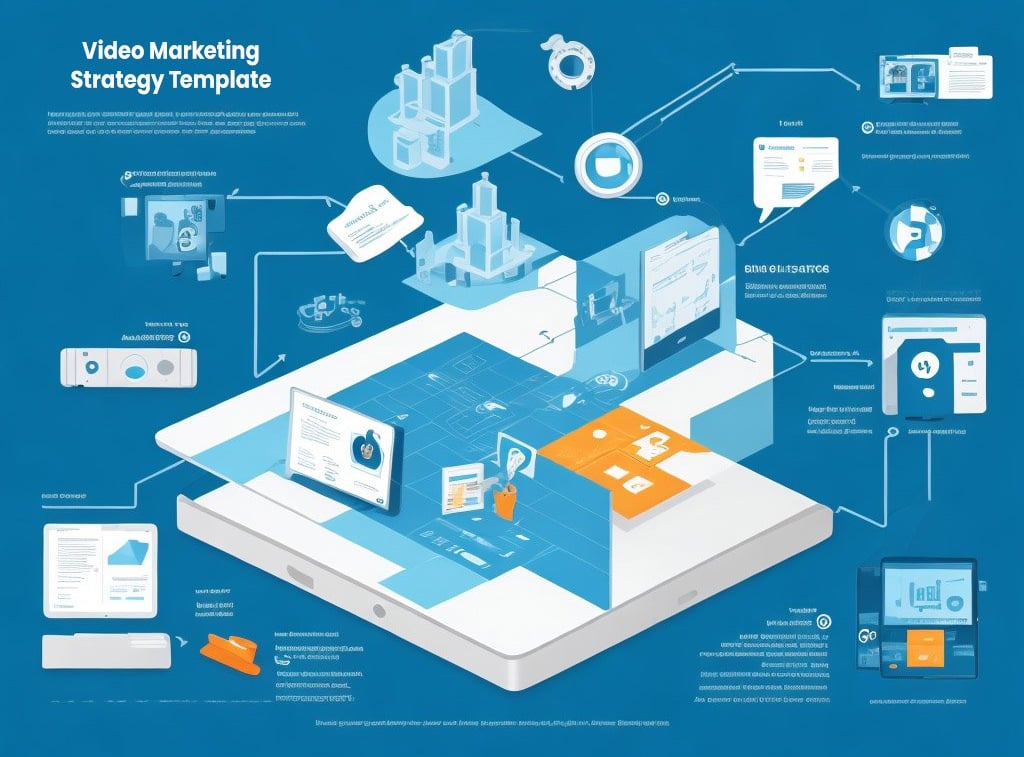Video Marketing Strategy Template


In today's digital age, video marketing has become a powerful tool for businesses to engage with their target audience and drive brand awareness. To help you navigate the world of video marketing, we present the "Video Marketing Strategy Template." This comprehensive template offers 12 blog post examples showcasing successful video marketing campaigns, providing valuable insights and ideas to create impactful videos. This template is designed to equip you with the knowledge and inspiration to leverage video's power effectively in your marketing efforts.

Determining Your Goals and Objectives
Defining your target audience
Before you start creating video content, defining your target audience is crucial. Who are you trying to reach with your videos? Understanding your audience's demographics, interests, and pain points will help you tailor your content to their preferences and needs.
Setting specific goals
Next, you need to set specific goals for your video marketing strategy. What do you want to achieve with your videos? Are you aiming to increase brand awareness, drive website traffic, or generate leads? Defining clear and measurable objectives that align with your overall marketing goals is essential.
Choosing the right metrics to measure success
Once you have defined your goals, you need to determine the metrics that will help you measure the success of your video marketing efforts. Some standard metrics to consider include video views, engagement (likes, comments, shares), click-through rates, conversion rates, and return on investment (ROI). By tracking these metrics, you can gain insights into the effectiveness of your videos and make data-driven decisions to optimize your strategy.


Creating Engaging
Video Content
Understanding your audience's preferences
You need to understand your audience's preferences to create engaging video content. What type of content do they enjoy consuming? Are they looking for educational, entertaining, or inspirational videos? Market research and analyzing your competitors' successful video campaigns can provide insights into what resonates with your target audience.
Developing a compelling story
One of the critical elements of successful video content is a compelling story. Your videos should have a straightforward narrative that captures your audience's attention and keeps them engaged until the end. Whether showcasing customer success stories, demonstrating product features, or telling an emotional journey, storytelling adds depth and relatability to your videos.
Utilizing different types of videos
Do not limit yourself to a single type of video. To engage your audience, you can create various kinds of videos, such as explainer videos, product demos, customer testimonials, behind-the-scenes footage, or live-streaming events. By diversifying your video content, you can cater to different preferences and provide a richer experience for your viewers.
Optimizing video length and format
The length and format of your videos can significantly impact viewer engagement. While attention spans are generally shorter in today's digital age, it's essential to balance keeping your videos concise and providing enough information. Experiment with different lengths and formats to determine what resonates best with your audience.
Choosing the Right
Video Platforms
Evaluating popular video hosting platforms
Several popular video hosting platforms exist, such as YouTube, Vimeo, Wistia, and Facebook. Each platform has strengths and audience reach, so evaluating its features, pricing, and analytics capabilities is essential to finding the best fit for your video marketing strategy.
Analyzing platform demographics
Understanding the demographics of the platforms you choose is crucial for effectively targeting your audience. Different platforms attract different user demographics, so aligning your video content with the platforms where your target audience is most likely to be present is essential. Analyze the age, gender, location, and interests of the platform's users to ensure your videos reach the right audience.
Considering SEO and discoverability
Video SEO is crucial in making your videos discoverable by search engines and users. Optimize your video titles, descriptions, and tags with relevant keywords to increase their visibility in search results. Additionally, consider incorporating closed captions and transcripts to enhance accessibility and improve search engine indexing.
Leveraging social media channels
To amplify the reach of your videos, promote and share your content on social media channels. Each platform has unique features and audience demographics, so tailor your video content accordingly. Engage with your audience, encourage sharing, and use social media analytics to measure the performance of your videos on different platforms.
Developing a Content Calendar
Identifying key dates and events
A content calendar is essential for planning and organizing your video content. Identify critical dates, events, and holidays relevant to your industry that you can create videos around. This will help you stay timely and topical and ensure your videos align with your marketing strategy.
Determining video release frequency
Consistency is vital when it comes to video marketing. Determine how often you will release new videos and establish a regular schedule. Whether weekly, bi-weekly, or monthly, setting a consistent release frequency helps build anticipation and keeps your audience engaged.
Aligning video content with marketing campaigns
Integrating your video content with your broader marketing campaigns is crucial for maximizing its impact. Map out your marketing campaigns and identify opportunities where video can enhance your messaging and storytelling. Create videos that align with the campaign goals and reinforce the key messages you want to convey.
Establishing a consistent posting schedule
In addition to determining release frequency, it's essential to establish a consistent posting schedule across your chosen video platforms. This ensures your audience knows when to expect new videos and encourages them to subscribe or follow your channels. Consistency builds trust and increases engagement with your videos.


Optimizing Video SEO
Keyword researching for video titles and descriptions
One of the critical aspects of video SEO is keyword research. Identify relevant keywords and phrases that align with your video content and your target audience's search queries. Incorporate these keywords in your video titles, descriptions, and tags to improve your videos' visibility in search results.
Crafting engaging thumbnails and video tags
Thumbnails and video tags are crucial in attracting viewers and improving click-through rates. Create visually appealing and relevant thumbnails that accurately represent your video content. Additionally, utilize descriptive and specific video tags to ensure your videos appear in related searches.
Transcribing and closed-captioning videos
Transcribing and closed captioning your videos not only enhances accessibility but also improves search engine indexing. Transcripts provide text-based content that search engines can crawl, increasing the chances of your videos appearing in relevant search results. Closed captioning also enables individuals with hearing impairments to engage with your videos.
Utilizing metadata and schema markup
Metadata and schema markup provide additional context and information about your videos to search engines. Use relevant metadata, including video duration, upload date, and targeted keywords, to improve your videos' SEO. Additionally, consider implementing schema markup to enhance the visibility and appearance of your videos in search engine results.
Promoting Your Videos
Sharing videos on social media platforms
Leverage your social media channels to share and promote your videos. Tailor your messaging to each platform and encourage your audience to engage with, comment on, and share your videos. Utilize features like live streaming, stories, and interactive elements to spark interest and drive traffic to your videos.
Collaborating with influencers and partners
Partnering with influencers and industry experts can significantly expand the reach of your videos. Identify influencers and partners whose audience aligns with your target audience and collaborate on video content. This increases your video's visibility and adds credibility and trust through association with respected figures in your industry.
Leveraging email marketing and newsletters
Email marketing and newsletters effectively promote your videos to your existing audience and subscribers. Embed videos directly in your email campaigns or create dedicated newsletters featuring your latest video content. Use compelling subject lines, personalized messaging, and clear calls to action (CTAs) to entice recipients to watch and share your videos.
Implementing paid video advertising
Paid video advertising can help amplify your videos' reach and targeted exposure. Platforms like YouTube and Facebook offer various advertising options, including in-stream ads, pre-roll ads, and sponsored content. Develop strategic paid advertising campaigns that align with your overall goals and target audience to maximize the impact of your video content.
Measuring and Analyzing Performance
Defining KPIs for video marketing
To measure the success of your video marketing efforts, it's essential to define key performance indicators (KPIs) that align with your goals. Some common video marketing KPIs include views, engagement metrics (likes, comments, shares), click-through rates, conversion rates, and ROI. Establish benchmarks and track these metrics consistently to assess the effectiveness of your videos.
Leveraging video analytics tools
Video hosting platforms provide robust analytics tools to measure and analyze the performance of your videos. Utilize these tools to gain insights into viewer behavior, demographics, and engagement metrics. Identify patterns, trends, and areas for improvement through data-driven analysis, and refine your video marketing strategy accordingly.
Analyzing viewer engagement and retention
Viewer engagement and retention metrics provide insights into how your audience interacts with your videos. Analyze metrics such as watch time, drop-off rates, and viewer feedback to assess the effectiveness of your video content and identify areas for improvement. The longer viewers stay engaged with your videos, the more likely they will convert and take desired actions.
Tracking conversion rates and ROI
Ultimately, the success of your video marketing strategy is measured by its impact on your bottom line. Track conversion rates to assess how your videos drive desired actions, such as website visits, lead generation, or sales. Evaluate your video marketing efforts’ return on investment (ROI) by comparing production and distribution costs to the revenue generated.
Continuously Improving Your Strategy
Conducting A/B testing for different video elements
A/B testing is an effective method to optimize your video marketing strategy. Test different elements of your videos, such as titles, thumbnails, descriptions, and calls to action, to determine which combinations perform best. By continuously experimenting and iterating based on data-driven insights, you can continually improve the effectiveness of your videos.
Collecting and incorporating viewer feedback
Listen to your audience and collect feedback on your videos. Encourage viewers to leave comments, ratings, and suggestions for improvement. Incorporate constructive input into your video content, production quality, and storytelling approach. By actively engaging with your audience, you can build stronger connections and create content that resonates with their needs and preferences.
Staying updated with video marketing trends
Video marketing trends and techniques are constantly evolving. Stay updated with the latest advancements, tools, and strategies in the industry. Attend industry conferences, webinars, and workshops and follow thought leaders in the video marketing space. By staying ahead of the curve, you can adapt and leverage new trends to remain relevant and maintain a competitive edge.
Monitoring competitors' video strategies
Monitor your competitors' video strategies to gain insights and inspiration. Analyze what types of videos they create, the platforms they leverage, and the engagement their videos receive. Identify gaps and opportunities in their approach and leverage them to differentiate your video marketing strategy. However, always strive to maintain your unique brand identity and storytelling style.
Integrating Video with Other Marketing Channels
Incorporating videos into blog posts and articles
Videos can enhance the storytelling and engagement of your blog posts and articles. Embed videos directly within your written content to provide visual and interactive elements. Use videos to demonstrate concepts, provide tutorials, or showcase product features. By incorporating videos, you can increase users' time on your blog and enhance their overall experience.
Using videos for email marketing campaigns
Video is a powerful tool to enhance your email marketing campaigns. Embed videos directly in your emails to capture attention and increase engagement rates. Use videos to deliver personalized messages, showcase new products or services, or provide exclusive behind-the-scenes content. Including videos in your email campaigns can significantly improve click-through rates and conversions.
Creating video landing pages and CTAs
Video landing pages create a dedicated space to showcase your content and encourage viewer engagement. Craft compelling headlines, descriptions, and calls to action (CTAs) that entice visitors to watch your videos. Use landing pages to collect viewer information, drive registrations, or encourage further exploration of your website. Video landing pages act as a focal point for your video marketing efforts.
Syndicating videos through partnerships
Syndicating your videos through partnerships with relevant industry websites, blogs, or influencers can significantly expand your reach. Identify potential partners who share your target audience and collaborate on cross-promotion. By tapping into established networks, you can leverage their existing audience base to increase the visibility and reach of your videos.
Budgeting for Video Marketing
Determining production costs
When budgeting for video marketing, consider the production costs involved. This includes video equipment, location fees, talent fees, scriptwriting, editing, and post-production expenses. Allocate resources based on the complexity and quality you aim to achieve with your videos. It's essential to balance production value and the available budget.
Allocating funds for video distribution
Allocate funds for video distribution in addition to production costs. This includes expenses for hosting platforms, paid advertising campaigns, and social media promotions. Consider your goals and target audience when determining how much to allocate for distribution. Investing in targeted distribution channels can amplify the impact of your videos and maximize your return on investment.
Considering outsourcing vs. in-house production
Based on your resources, expertise, and budget, decide whether to outsource video production or keep it in-house. Outsourcing may provide access to specialized skills and professional production value, but it comes with additional costs. In-house production offers more control and cost-efficiency but requires skilled personnel and equipment. Consider the pros and cons of each option before deciding what works best for your organization.
Evaluating return on investment
Evaluate the return on investment (ROI) of your video marketing efforts to determine the effectiveness of your strategy. Compare the costs incurred in production and distribution to the revenue generated, additional leads or conversions, and brand awareness metrics. Regularly analyze and adjust your video marketing budget based on the ROI achieved.

